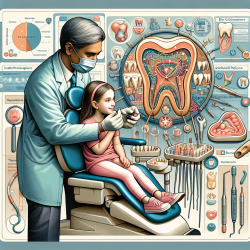Introduction
The recent study titled "Targeting the ALS/FTD-associated A-DNA kink with anthracene-based metal complex causes DNA backbone straightening and groove contraction" provides intriguing insights into novel therapeutic strategies for amyotrophic lateral sclerosis (ALS) and frontotemporal dementia (FTD). These neurodegenerative disorders are linked to the abnormal expansion of the GGGGCC (G4C2) hexanucleotide repeat within the C9orf72 gene. This blog explores how practitioners can leverage these findings to enhance therapeutic approaches and encourages further research in this promising area.
Understanding the Research Findings
The study uncovers that the G4C2 repeat motif in DNA and RNA-DNA hybrid duplexes adopts unique structural conformations. The DNA duplex displays an A-DNA-like structure with B-form characteristics, while the RNA-DNA hybrid maintains a more rigid A-form. The research highlights the flexibility and hydration shell of the DNA duplex, which serves as a hotspot for binding with anthracene-based nickel complexes, NiII(Chro)2. This binding results in the contraction of the minor groove and straightening of the DNA backbone, suggesting a new direction for drug discovery targeting ALS and FTD.
Implications for Practitioners
For practitioners in the field of neurological disorders, these findings offer several implications:
- Targeted Drug Development: The study suggests that targeting the G4C2 repeat motif with specific metal complexes can stabilize the DNA structure, potentially reducing toxic RNA transcripts and proteins. This approach opens new avenues for drug development focused on DNA rather than RNA, offering a complementary strategy to existing therapies.
- Therapeutic Strategy Diversification: By exploring DNA-targeting compounds, practitioners can diversify therapeutic strategies, potentially improving outcomes for patients with ALS and FTD. This could lead to more personalized treatment plans based on the specific genetic and molecular profiles of patients.
- Encouraging Further Research: The study encourages further exploration into the structural dynamics of DNA and RNA-DNA hybrids in neurodegenerative disorders. Practitioners can collaborate with researchers to develop and test new compounds, contributing to a deeper understanding of these diseases.
Encouraging Further Research
While the study provides a solid foundation, further research is essential to fully realize the therapeutic potential of targeting G4C2 repeats. Practitioners are encouraged to engage in collaborative research efforts, focusing on:
- Structural Analysis: Conducting detailed structural analyses of DNA and RNA-DNA hybrids to identify additional binding sites and improve the specificity of potential therapeutic compounds.
- Compound Development: Developing and testing new anthracene-based metal complexes and other small molecules to enhance binding affinity and therapeutic efficacy.
- Clinical Trials: Initiating clinical trials to evaluate the safety and effectiveness of these compounds in patients with ALS and FTD, paving the way for new treatment options.
Conclusion
The research on targeting the G4C2 repeat motif with anthracene-based metal complexes offers a promising new direction for treating ALS and FTD. By leveraging these findings, practitioners can enhance therapeutic approaches and contribute to the ongoing effort to combat these challenging neurodegenerative disorders. To read the original research paper, please follow this link: Targeting the ALS/FTD-associated A-DNA kink with anthracene-based metal complex causes DNA backbone straightening and groove contraction.










